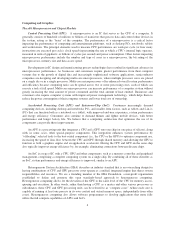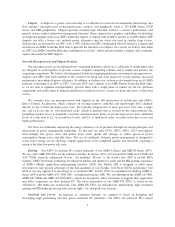AMD 2014 Annual Report Download - page 20
Download and view the complete annual report
Please find page 20 of the 2014 AMD annual report below. You can navigate through the pages in the report by either clicking on the pages listed below, or by using the keyword search tool below to find specific information within the annual report.The remaining wafers for our products are delivered from third-party foundries to our test, assembly and
packaging partners located in the Asia-Pacific region who package and test our final semiconductor products.
Intellectual Property and Licensing
We rely on contracts and intellectual property rights to protect our products and technologies from
unauthorized third-party copying and use. Intellectual property rights include copyrights, patents, patent
applications, trademarks, trade secrets and maskwork rights. As of December 27, 2014, we had approximately
4,900 patents in the United States and approximately 1,200 patent applications pending in the United States. In
certain cases, we have filed corresponding applications in foreign jurisdictions. We expect to file future patent
applications in both the United States and abroad on significant inventions, as we deem appropriate. We do not
believe that any individual patent, or the expiration of any patent, is or would be material to our business.
As is typical in the semiconductor industry, we have numerous cross-licensing and technology exchange
agreements with other companies under which we both transfer and receive technology and intellectual property
rights. One such agreement is the cross license agreement that we entered into with Intel on November 11, 2009.
Under the cross license agreement, we granted to Intel and Intel granted to us, non-exclusive, royalty-free
licenses to all of each other’s patents that were first filed no later than November 11, 2014 and each party can
exploit these patents anywhere in the world for making and selling certain semiconductor- and electronic-related
products. Under the cross license agreement, Intel has rights to make semiconductor products for third parties,
but the third-party product designs are not licensed as a result of such manufacture. We have rights to perform
assembly and testing for third parties but not rights to make semiconductor products for third parties. The term of
the cross license agreement continues until the expiration of the last to expire of the licensed patents, unless
earlier terminated. A party can terminate the cross license agreement or the rights and licenses of the other party
if the other party materially breaches the cross license agreement and does not correct the noticed material breach
within 60 days. Upon such termination, the terminated party’s license rights terminate but the terminating party’s
license rights continue, subject to that party’s continued compliance with the terms of the cross license
agreement. The cross license agreement will automatically terminate if a party undergoes a change of control (as
defined in the cross license agreement), and both parties’ licenses will terminate. Upon the bankruptcy of a party,
that party may assume, but may not assign, the cross license agreement, and in the event that the cross license
agreement cannot be assumed, the cross license agreement and the licenses granted will terminate.
Backlog
Sales are made primarily pursuant to purchase orders for current delivery or agreements covering purchases
over a period of time. Some of these orders or agreements may be revised or canceled without penalty. Generally,
in light of current industry practice, we do not believe that such orders or agreements provide meaningful
backlog figures or are necessarily indicative of actual sales for any succeeding period.
Seasonality
Our operating results tend to vary seasonally. For example, historically, first quarter PC product sales are
generally lower than fourth quarter sales. In addition, with respect to our semi-custom SoC products for game
consoles, we expect sales patterns to follow the seasonal trends of a consumer business with sales in the first half
of the year being lower than sales in the second half of the year.
Employees
As of December 27, 2014, we had approximately 9,700 employees.
Environmental Regulations
Many aspects of our business operations and products are regulated by domestic and international
environmental laws and regulations. These regulations include limitations on discharge of pollutants to air, water,
14
























